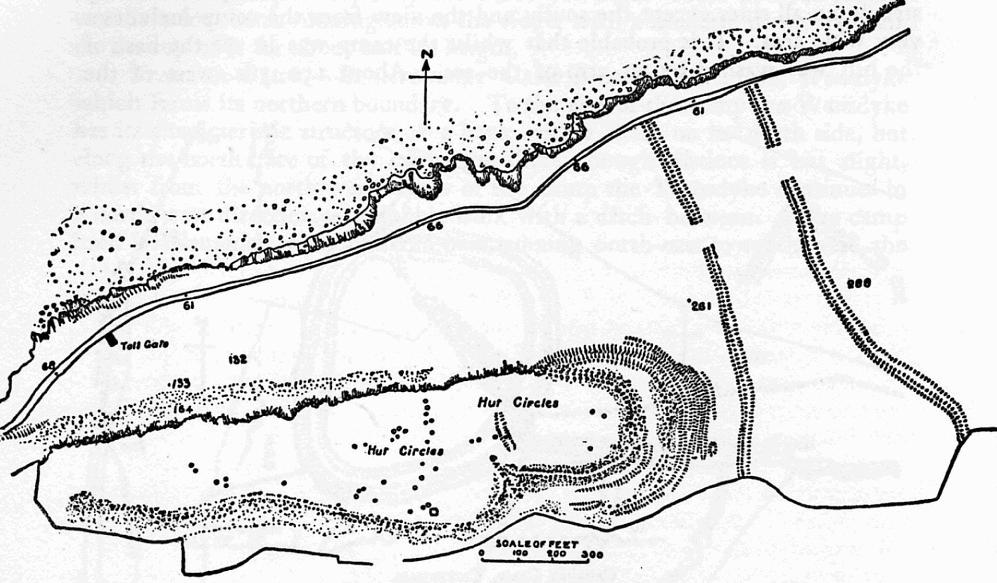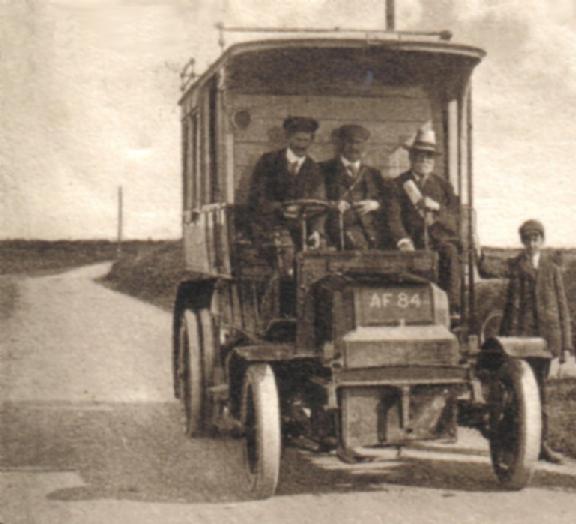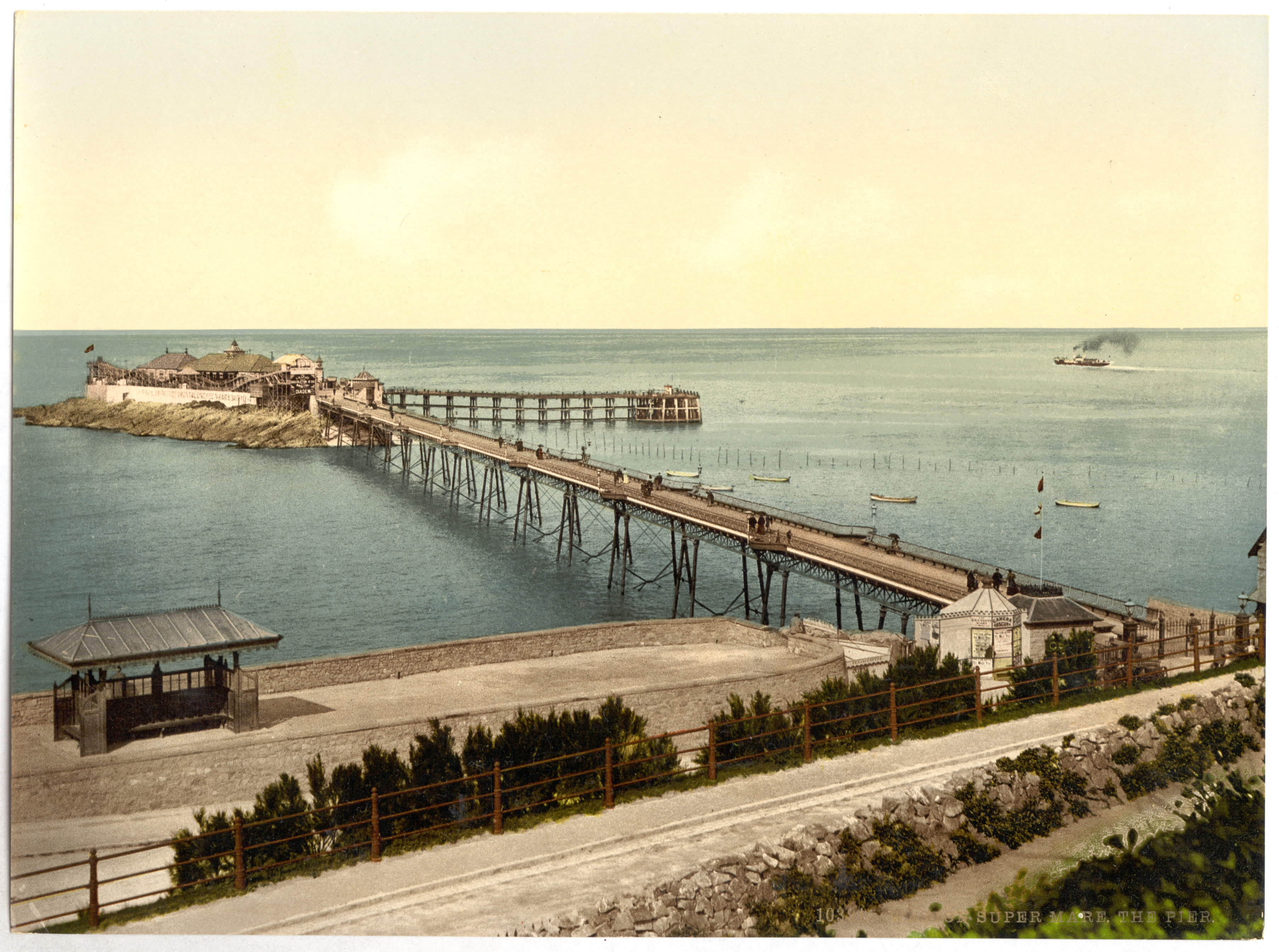|
Weston-super-Mare Tramways
The Weston-super-Mare Tramways were the electric street tramways of the seaside resort of Weston-super-Mare in Somerset, England. It operated a fleet of up to 16 standard gauge single- and double-deck tramcars on routes totalling to Birnbeck Pier, The Sanatorium and Locking Road. It opened in 1902 and was replaced by bus services in 1937. History There were three abortive schemes to open tramways in Weston-super-Mare during the last two decades of the nineteenth century. A scheme was promoted in 1882 for a steam tram network to serve the railway station, the town centre and Birnbeck Pier.* In 1885 the Weston, Clevedon and Portishead Tramway gained an Act of Parliament that allowed it to construct a tramway along The Boulevard, Gerrard Road and Milton Road to Ashcombe Road, from where it would continue across fields towards Portishead. Although rails were laid in 1894 they were taken up again three years later, and Ashcombe Road became the tramway's terminus when it finally ... [...More Info...] [...Related Items...] OR: [Wikipedia] [Google] [Baidu] |
Weston-super-Mare
Weston-super-Mare, also known simply as Weston, is a seaside town in North Somerset, England. It lies by the Bristol Channel south-west of Bristol between Worlebury Hill and Bleadon Hill. It includes the suburbs of Mead Vale, Milton, Oldmixon, West Wick, Worlebury, Uphill and Worle. Its population at the 2011 census was 76,143. Since 1983, Weston has been twinned with Hildesheim in Germany. The local area has been occupied since the Iron Age. It was still a small village until the 19th century when it developed as a seaside resort. A railway station and two piers were built. In the second half of the 20th century it was connected to the M5 motorway but the number of people holidaying in the town declined and some local industries closed, although the number of day visitors has risen. Attractions include The Helicopter Museum, Weston Museum, and the Grand Pier. Cultural venues include The Playhouse, the Winter Gardens and the Blakehay Theatre. The Bristol Channel has a l ... [...More Info...] [...Related Items...] OR: [Wikipedia] [Google] [Baidu] |
GWR Road Motor Services
The Great Western Railway road motor services operated from 1903 to 1933 by the Great Western Railway, both as a feeder to their train services, and as a cheaper alternative to building new railways in rural areas. They were the first successful bus services operated by a British railway company. History Faced with an estimate of £85,000 to build a light railway to serve the area south of Helston in Cornwall, the Great Western Railway (GWR) decided to test the market with bus services on the route. They learnt that the Lynton and Barnstaple Railway had been forced by local officialdom to cease using the two buses on their pioneering connection to Ilfracombe and so the GWR bought them to operate a Helston service. The service proved so popular and profitable that further routes were soon established at Penzance and Slough. By the end of 1904, 36 buses were in operation, 10 more than were in service in London. When the Great Western Railway (Road Transport) Act was passed in 1928 ... [...More Info...] [...Related Items...] OR: [Wikipedia] [Google] [Baidu] |
Blacksmith
A blacksmith is a metalsmith who creates objects primarily from wrought iron or steel, but sometimes from #Other metals, other metals, by forging the metal, using tools to hammer, bend, and cut (cf. tinsmith). Blacksmiths produce objects such as gates, grilles, railings, light fixtures, furniture, sculpture, tools, agricultural implements, decorative and religious items, cooking utensils, and weapons. There was an historical distinction between the heavy work of the blacksmith and the more delicate operation of a whitesmith, who usually worked in Goldsmith, gold, Silversmith, silver, pewter, or the finishing steps of fine steel. The place where a blacksmith works is called variously a smithy, a forge or a blacksmith's shop. While there are many people who work with metal such as farriers, wheelwrights, and Armourer, armorers, in former times the blacksmith had a general knowledge of how to make and repair many things, from the most complex of weapons and armor to simple things ... [...More Info...] [...Related Items...] OR: [Wikipedia] [Google] [Baidu] |
Corrugated Iron
Corrugated galvanised iron or steel, colloquially corrugated iron (near universal), wriggly tin (taken from UK military slang), pailing (in Caribbean English), corrugated sheet metal (in North America) and occasionally abbreviated CGI is a building material composed of sheets of hot-dip galvanised mild steel, cold-rolled to produce a linear ridged pattern in them. Although it is still popularly called "iron" in the UK, the material used is actually steel (which is iron alloyed with carbon for strength, commonly 0.3% carbon), and only the surviving vintage sheets may actually be made up of 100% iron. The corrugations increase the bending strength of the sheet in the direction perpendicular to the corrugations, but not parallel to them, because the steel must be stretched to bend perpendicular to the corrugations. Normally each sheet is manufactured longer in its strong direction. CGI is lightweight and easily transported. It was and still is widely used especially in rural a ... [...More Info...] [...Related Items...] OR: [Wikipedia] [Google] [Baidu] |
Banwell
Banwell is a village and civil parish on the River Banwell in the North Somerset district of Somerset, England. Its population was 2,919 according to the 2011 census. History Banwell Camp, east of the village, is a univallate hillfort which has yielded flint implements from the Palaeolithic, Neolithic and Bronze Age. It was also occupied in the Iron Age. In the late 1950s it was excavated by J.W. Hunt of the Banwell Society of Archaeology. It is surrounded by a high bank and ditch. The remains of a Romano-British villa were discovered in 1968. It included a courtyard, wall and bath house close to the River Banwell. Artefacts from the site suggest it fell into disuse in the 4th century. Earthworks from farm buildings, south of Gout House Farm, occupied from the 11th to 14th centuries where archaeological remains suggest the site was first occupied in the Romano-British period. The raised area which was occupied by the Bower House was surrounded by a water filled ditch, part o ... [...More Info...] [...Related Items...] OR: [Wikipedia] [Google] [Baidu] |
Indian Red
Indian red is a pigment, a variety of ocher, which gets its colour from ferric oxide, produced in India. Other shades of iron oxides include Venetian red, Venetian Red, #English red, English Red, and #Kobe, Kobe, all shown below. Chestnut (color), Chestnut is a colour similar to but separate and distinct from Indian red. Etymology The name ''Indian red'' derives from the red laterite soil found in India, which is composed of naturally occurring iron oxides. The first recorded use of ''Indian red'' as a color term in English language, English was in 1672. Variations of Indian red Venetian red At right is displayed the colour Venetian red. ''Venetian red'' is a light and warm (somewhat unsaturated) pigment that is a darker shade of scarlet (color), scarlet, derived from nearly pure ferric oxide (Fe2O3) of the hematite type. Modern versions are frequently made with synthetic red iron oxide. The first recorded use of ''Venetian red'' as a colour name in English was in 1753. ... [...More Info...] [...Related Items...] OR: [Wikipedia] [Google] [Baidu] |
Gold Leaf
Gold leaf is gold that has been hammered into thin sheets (usually around 0.1 µm thick) by goldbeating and is often used for gilding. Gold leaf is available in a wide variety of karats and shades. The most commonly used gold is 22-karat yellow gold. Gold leaf is a type of metal leaf, but the term is rarely used when referring to gold leaf. The term ''metal leaf'' is normally used for thin sheets of metal of any color that do not contain any real gold. Pure gold is 24 karat. Real, yellow gold leaf is approximately 91.7% pure (i.e. 22-karat) gold. Silver-colored white gold is about 50% pure gold. Layering gold leaf over a surface is called gold leafing or gilding. Traditional water gilding is the most difficult and highly regarded form of gold leafing. It has remained virtually unchanged for hundreds of years and is still done by hand. In art Gold leaf is sometimes used in art in a "raw" state, without a gilding process. In cultures including the European Bronze Age it ... [...More Info...] [...Related Items...] OR: [Wikipedia] [Google] [Baidu] |
Carmine
Carmine ()also called cochineal (when it is extracted from the cochineal insect), cochineal extract, crimson lake, or carmine lake is a pigment of a bright-red color obtained from the aluminium complex derived from carminic acid. Specific code names for the pigment include natural red 4, C.I. 75470, or E120. ''Carmine'' is also a general term for a particularly deep-red color. Etymology The English word "carmine" is derived from the French word ''carmin'' (12th century), from Medieval Latin ''carminium'', from Persian ''qirmiz'' ("crimson"), which itself derives from Middle Persian ''carmir'' ("red, crimson"). The Persian term ''carmir'' is likely cognate with Sanskrit ''krimiga'' ("insect-produced"), from ''krmi'' ("worm, insect"). The Persian word for "worm, insect" is ''kirm'', and in Iran (Persia) the red colorant carmine was extracted from the bodies of dead female insects such as ''Kermes vermilio'' and cochineal. The form of the term may also have been influen ... [...More Info...] [...Related Items...] OR: [Wikipedia] [Google] [Baidu] |
Weston-super-Mare Tramcar 16 Near Oxford Street
Weston-super-Mare, also known simply as Weston, is a seaside town in North Somerset, England. It lies by the Bristol Channel south-west of Bristol between Worlebury Hill and Bleadon Hill. It includes the suburbs of Mead Vale, Milton, Oldmixon, West Wick, Worlebury, Uphill and Worle. Its population at the 2011 census was 76,143. Since 1983, Weston has been twinned with Hildesheim in Germany. The local area has been occupied since the Iron Age. It was still a small village until the 19th century when it developed as a seaside resort. A railway station and two piers were built. In the second half of the 20th century it was connected to the M5 motorway but the number of people holidaying in the town declined and some local industries closed, although the number of day visitors has risen. Attractions include The Helicopter Museum, Weston Museum, and the Grand Pier. Cultural venues include The Playhouse, the Winter Gardens and the Blakehay Theatre. The Bristol Channel has a ... [...More Info...] [...Related Items...] OR: [Wikipedia] [Google] [Baidu] |
Swansea Improvements And Tramway Company
The Swansea Improvements and Tramway Company operated street trams in and around Swansea in Wales from 1878 to 1937. Background Swansea is Wales's second city and was a leader in the Industrial Revolution owing to the ready availability of local resources of coal and good access via its seaport to imported metal ores, especially copper, from the West Country, Cornwall and Devon. The city is constrained geographically by high hills landwards from Swansea Bay giving the city a reversed 'L' shape. Transport was a particular issue for the rapidly expanding town (as it was before the investiture of the Prince of Wales in 1969 made it a city). Industry and workers' housing was expanding northwards towards Morriston, up the Swansea Valley whilst wealthier homes spread westwards along the coast towards Sketty. The world's first passenger railway, the Swansea and Mumbles Railway (SMR), had demonstrated the power of rails to carry passengers but a street tramway was not considered unti ... [...More Info...] [...Related Items...] OR: [Wikipedia] [Google] [Baidu] |
Weston-super-Mare Tramcar 1 Tbc At Oxford Street Junction
Weston-super-Mare, also known simply as Weston, is a seaside town in North Somerset, England. It lies by the Bristol Channel south-west of Bristol between Worlebury Hill and Bleadon Hill. It includes the suburbs of Mead Vale, Milton, Oldmixon, West Wick, Worlebury, Uphill and Worle. Its population at the 2011 census was 76,143. Since 1983, Weston has been twinned with Hildesheim in Germany. The local area has been occupied since the Iron Age. It was still a small village until the 19th century when it developed as a seaside resort. A railway station and two piers were built. In the second half of the 20th century it was connected to the M5 motorway but the number of people holidaying in the town declined and some local industries closed, although the number of day visitors has risen. Attractions include The Helicopter Museum, Weston Museum, and the Grand Pier. Cultural venues include The Playhouse, the Winter Gardens and the Blakehay Theatre. The Bristol Channel has a ... [...More Info...] [...Related Items...] OR: [Wikipedia] [Google] [Baidu] |
Basalt
Basalt (; ) is an aphanite, aphanitic (fine-grained) extrusive igneous rock formed from the rapid cooling of low-viscosity lava rich in magnesium and iron (mafic lava) exposed at or very near the planetary surface, surface of a terrestrial planet, rocky planet or natural satellite, moon. More than 90% of all volcanic rock on Earth is basalt. Rapid-cooling, fine-grained basalt is chemically equivalent to slow-cooling, coarse-grained gabbro. The eruption of basalt lava is observed by geologists at about 20 volcanoes per year. Basalt is also an important rock type on other planetary bodies in the Solar System. For example, the bulk of the plains of volcanism on Venus, Venus, which cover ~80% of the surface, are basaltic; the lunar mare, lunar maria are plains of flood-basaltic lava flows; and basalt is a common rock on the surface of Mars. Molten basalt lava has a low viscosity due to its relatively low silica content (between 45% and 52%), resulting in rapidly moving lava flo ... [...More Info...] [...Related Items...] OR: [Wikipedia] [Google] [Baidu] |








_04_ies.jpg)



